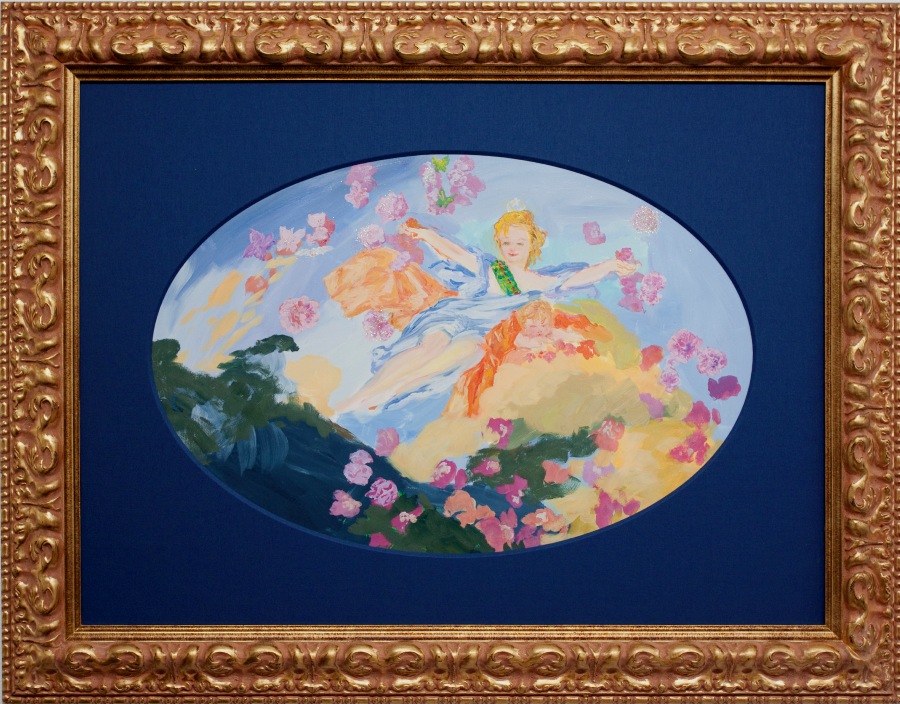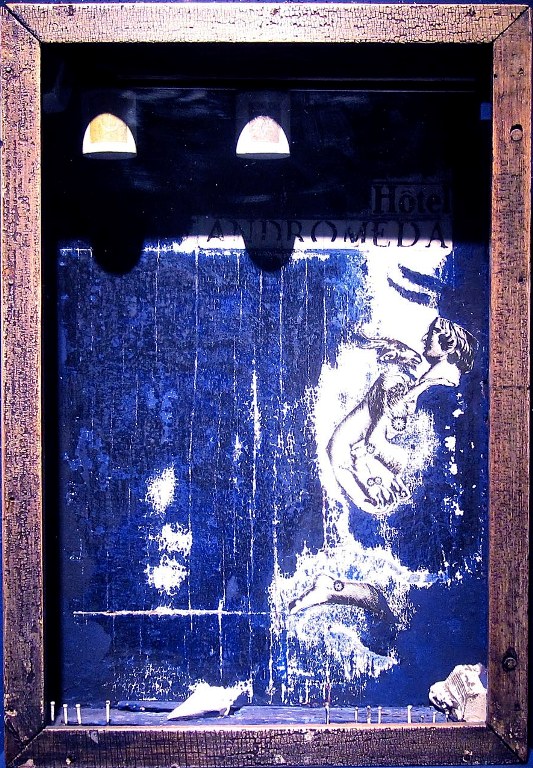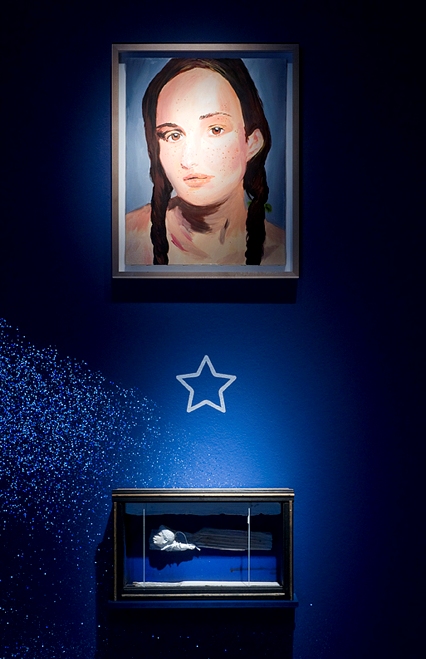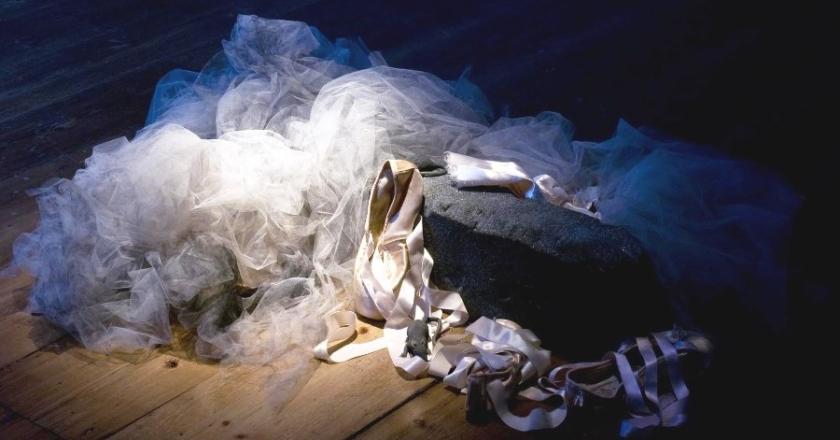The gallery has been turned into a little girl’s dressing-up closet. The walls are painted midnight blue and dusted with glitter. Ballet shoes, made for small feet, and a discarded tutu are to be found in a decorous pile on the floor. There are shiny trinkets and princessy things and pictures of ballerinas in bright, pastel shades. And miniature cabinets, almost empty but for one or two small objects – old, discardable things that might be hoarded away as treasures by a child wrapped up in its own imaginary world.
 I’m not quite sure what Joseph Cornell would have made of all this – his quiet, spare, sad little assemblages – those glass-fronted “cabinets" – displayed alongside Karen Kilimnik’s brash, postmodern homages to Degas’ little ballerinas and Boucher’s rococo delights (pictured right: Aurora and Assistants Spreading Happiness and Light; 2009) all accompanied by a piped soundtrack of Swan Lake. But as the celebrated pioneer of assemblages has been dead for almost 40 years, we can’t ask him.
I’m not quite sure what Joseph Cornell would have made of all this – his quiet, spare, sad little assemblages – those glass-fronted “cabinets" – displayed alongside Karen Kilimnik’s brash, postmodern homages to Degas’ little ballerinas and Boucher’s rococo delights (pictured right: Aurora and Assistants Spreading Happiness and Light; 2009) all accompanied by a piped soundtrack of Swan Lake. But as the celebrated pioneer of assemblages has been dead for almost 40 years, we can’t ask him.
We know, however, that Cornell was, like Kilimnik, fascinated by the ballet. He contributed numerous old-fashioned-looking cover designs for issues of a thin little pamphlet called Dance Index and further expressed his appreciation with a series of boxed collages that he called Homage to The Romantic Ballet. And he was a hoarder. His collections of little, discardable treasures were used to make collages and arrangements of bric-a-brac in boxes. Influenced by the Surrealist technique of irrational juxtaposition, these assemblages manage to evoke a feeling of wistful, nostalgic reverie.
 Audiences are fascinated by Cornell because, despite living in New York and being tremendously well-read and cognisant of avant-garde movements, he lived such a closed, isolated life, especially in his latter years. And that makes him a strange and interesting figure, rather in the naïf, outsider mould. He often described himself as “the armchair voyager” and this is an apt description. Through an obsessive collecting of ephemera – postcards, old photos, travel guidebooks, magazine illustrations, etchings and postage stamps – he indeed “travelled” to different eras and fanciful, faraway lands. And rather like a wistful child, he imbued his small objects with representational meaning, so that small white, translucent cubes "became" ballet dancers.
Audiences are fascinated by Cornell because, despite living in New York and being tremendously well-read and cognisant of avant-garde movements, he lived such a closed, isolated life, especially in his latter years. And that makes him a strange and interesting figure, rather in the naïf, outsider mould. He often described himself as “the armchair voyager” and this is an apt description. Through an obsessive collecting of ephemera – postcards, old photos, travel guidebooks, magazine illustrations, etchings and postage stamps – he indeed “travelled” to different eras and fanciful, faraway lands. And rather like a wistful child, he imbued his small objects with representational meaning, so that small white, translucent cubes "became" ballet dancers.
The assemblages shown here aren’t among his best work, but one certainly gets a sense of why people fall for Cornell’s romantic, sweetly melancholic vision. Untitled (Grand Hotel) c 1950, is a wooden box painted white with two wooden “pillars”. Pasted inside is what looks like an Edwardian print of an engraving of a girl’s face – like one of those black and white illustrations advertising soap. And a small ball the size of a large marble. Another, Hotel Andromeda, 1954 (pictured above left), contains small shells and classical Greek marine imagery. Evidently, these are abandoned “ hotels”, past their glory days but retaining the charm of something old and disused.
 American artist Kilimnik wouldn’t be an obvious choice to show alongside Cornell, though they do share a common interest and a fondness for looking back through the eyes of an innocent. Two Americans sharing a kind of uncorrupted, Jamesian vision of the old world, perhaps. But it’s hard to see how they share a similar sensibility, for Kilimnik’s sense of the past borders – one guesses not entirely intentionally – on parody and high camp. Here she “does” Degas, a painting of dancers in a studio, executed not in delicate pastels with a draughtman-like precision, but with expressionistic brushstrokes in bright, acid-pastel colours. Her style hasn’t changed from when she was paying homage to her favourite celebrities Paris Hilton and Hugh Grant, in portraits gleaned from photographs. By contrast, the simplicity of her self-portrait as a young girl, Me, Corner of Haight Ashbury 1966, 1998 (pictured right, with Cornell assemblage), avoids that sense of self-infatuation.
American artist Kilimnik wouldn’t be an obvious choice to show alongside Cornell, though they do share a common interest and a fondness for looking back through the eyes of an innocent. Two Americans sharing a kind of uncorrupted, Jamesian vision of the old world, perhaps. But it’s hard to see how they share a similar sensibility, for Kilimnik’s sense of the past borders – one guesses not entirely intentionally – on parody and high camp. Here she “does” Degas, a painting of dancers in a studio, executed not in delicate pastels with a draughtman-like precision, but with expressionistic brushstrokes in bright, acid-pastel colours. Her style hasn’t changed from when she was paying homage to her favourite celebrities Paris Hilton and Hugh Grant, in portraits gleaned from photographs. By contrast, the simplicity of her self-portrait as a young girl, Me, Corner of Haight Ashbury 1966, 1998 (pictured right, with Cornell assemblage), avoids that sense of self-infatuation.
Sometimes Kilimnik elaborately frames her paintings, as we see in Aurora, and around these paintings she creates an immersive world of pretty, girlish things (though, if you look carefully you might see plastic rats among the tulle and ballet shoes.) If you’re prepared to abandon your cynicism, there is, in fact, something a little seductive about Kilimnik’s installations.
Kilimnik and Cornell make for an interesting coupling, though perhaps Kilimnik is the more domineering party, in danger of shouting down her quieter, more reflective companion.









![SEX MONEY RACE RELIGION [2016] by Gilbert and George. Installation shot of Gilbert & George 21ST CENTURY PICTURES Hayward Gallery](/sites/default/files/styles/thumbnail_125_x_125_/public/mastimages/Gilbert%20%26%20George_%2021ST%20CENTURY%20PICTURES.%20SEX%20MONEY%20RACE%20RELIGION%20%5B2016%5D.%20Photo_%20Mark%20Blower.%20Courtesy%20of%20the%20Gilbert%20%26%20George%20and%20the%20Hayward%20Gallery._0.jpg?itok=3oW-Y84i)





Add comment